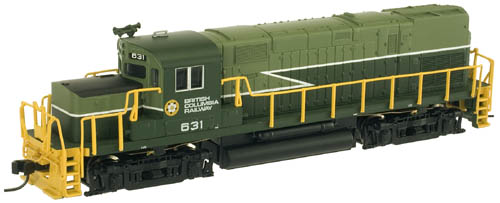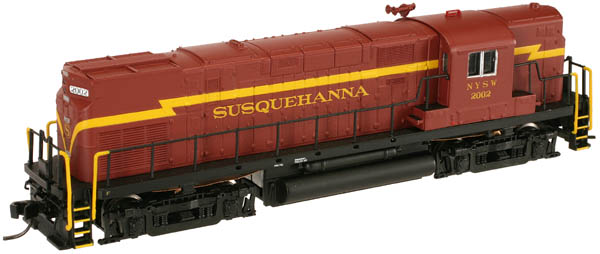| Phase 1 | Phase 2 |
 |  |
| Phase 1 | Phase 2 |
 |  |

Introduced: 2007 (Phase 1), 2008 (Phase 2), 2009 (Phase 1 High Hood), and 2020 (DCC-Sound Versions)
There have been two distinctly different versions of the chassis used in these models. The original (2007) version is fairly typical of Atlas diesels from that era -

The DCC-Ready chassis is all-metal and split-frame. The "Scale Speed" motor is five-pole and skew-wound. Each motorshaft has a large brass flywheel. All wheels provide pickup via low-friction axle-cup wipers. There are no traction tires. All axles are geared and all gearing is plastic. The main PC board (or decoder) provides directional "golden white" LED lighting. The wheels are blackened and low-profile. Couplers are shell-mounted Accumates.
Performance on these pre-2020 models is perfect in every way - smooth, quiet, flawless pickup and throttle response, exceptional pulling power, etc.
In 2020, the internals were completely redesigned to include support for an ESU LokSound DCC-Sound decoder and accompanying speaker. Analog versions were also part of this release. Instead of using screws and hex nuts to hold the chassis halves together, this new version uses plastic clips on either end of the chassis (the fuel tank and motor saddle also contribute to holding things together) -
Gone are the chassis contact strips that the truck axle-wipers used to rub up against (an Atlas staple since the 1980's). Instead, small wires are soldered to the axle-wipers on the one end and to cylindrical metal plugs (which insert into holes in the chassis) on the other. Note that the plugs are rather tight-fitting, so it's best to push them out from the inside (as opposed to trying to pull them out from the outside).
The rest of the internals are more or less the same as before. A five-pole / skew-wound motor spins dual flywheels. In turn, the flywheels spin plastic shafts with notched-cups on the worm side. Said cups spin little ball-and-pin connectors on the wormshafts. Bearing blocks inside of notches in the chassis hold the brass worms in place. A long plastic shield is clipped to the top of the chassis (dunno why - but maybe to prevent short circuits between the decoder and chassis?).
One noteworthy change is that Atlas revised the shroud around the headlight LED to better work with the new ESU PC boards (something that they didn't bother with on some of their other 2019-20 diesel re-releases, and with the end result there being lights that either provided too much light or no light at all).
I particularly like the way the circuit boards (and contacts thereto) have been redesigned. Very similar to IMRC's SD40-2 of 2017, metal contacts on the motor saddle transfer current from the main PC board (or decoder) to the motor and to the speaker mounted inside the fuel tank (note that even the non-sound locos come with a speaker). Unlike previous Atlas locos, the main PC board slides in and out of its chassis slots without requiring that one first partially disassemble the chassis (a nicety that Kato has offered for years). The design and placement of the new PC board contacts is also an improvement over previous Atlas diesels (where getting the motor contacts to line up with the contact pads on the PC board was admittedly a bit "hit and miss").
All eight wheels provide pickup, all four axles are geared, and all gearing is plastic. The wheels are blackened and low-profile. The trucks and fuel tank appear to be the same as on previous versions (in fact, the fuel tank still bears its "2007" copyright stamp). Note that speaker holes in the fuel tank aren't really required since the speaker is positioned such that sound projects upward rather than downward.
The shells are all plastic and include separate detail parts for the windows, numberboards, handrails, cab, sidesills, and horn. Couplers are shell-mounted Accumates.
Performance on this new version is every bit the equal of its predecessors. Out of the box, I didn't have any problems with the wheel-blackening causing any sort of jitteriness. They run very quietly, throttle response is smooth, pickup is flawless, slow speed creep is "one-time-at-a-time" and the top-end speed is realistic (IE, not too fast). Pulling power is strong, with mine comfortably able to haul thirty assorted 40' freight cars through curves on level track. No problems with any of the wheels derailing (even on 9.75" radius curves). Overall, just really superb looking and running models.
The sound on the DCC-Sound versions is well rendered and nicely beefy. And for a change, the default settings for volume are quite reasonable. I didn't notice any difference in performance when operating mine with an analog powerpack (IE, they run equally well using DCC or DC control). As seems to be typical with DCC-Sound models these days, the decoders in these locos are programmed to go through a rather protracted sequence of "start up" shenanigans before they start moving (and with similar behavior when slowing down). To eliminate this nonsense (if you're so inclined), simply set CV124 to 0. Also note that the default behavior is for the sound to be off (IE, put the loco on the rails and it won't make a peep). To turn sound on, hit F8. Unfortunately, none of this information is included with the model (handy paper inserts apparently being a thing of the past), so you'll need to hunt down the appropriate .pdf manual on the Atlas website when you have questions. IE, welcome to the 21st century.
Standard Features -
- Flat or "step" pilots used where appropriate
- Long hood with or without dynamic brake detail used where appropriate
- 3,100 or 2,400 gallon fuel tank used when appropriate per road name
- Low nose headlight in low position used where appropriate per road name
- Separately-applied coupler cut levers
- Painted safety rails
- Dual flywheels
- Directional lighting
- Blackened metal wheels
- Scale Speed motor
- Factory installed AccuMate couplers
DCC Features -
- Supports all DCC-programming modes
- DCC includes RailCom and RailComPlus, with 14, 28 or 128 speed steps and with 2-digit and 4-digit addressing.
- Flexible mapping of function keys F0 to F28.
- A total of 6 DCC function outputs are available, and all can be function mapped (disable, brightness, light effects) individually
- Follows all NMRA DCC standards and recommended practices.
- Over 20 sound effects are available, including engine start-up and shutdown, prime mover sounds through all eight notches, bell, air horn, air compressor, dynamic brakes and more.
- There are up to 16 user-selectable horns, 2 user-selectable bells, and 2 user-selectable synchronized brake squeals.
- Manual and Automatic Notching modes with the ability to change modes "on the fly" are provided for true realism.
- Equipped with ESU’s Exclusive "Full Throttle" features for ultimate realism.
Prototype information -
ALCo built a total of 131 Century 420 locomotives between 1963 and 1969, when the builder ceased all new locomotive production.
Powered by a 12-cylinder, turbocharged, 2,000-hp 251-series prime mover, the C420's direct competitor in 1963 was the EMD GP18. In fact, EMD did not offer a 12-cylinder, 2,000-hp prime mover until the GP39 model was produced in 1969. The shorter 12-cylinder engine block allowed the C420 to have its distinctive set-back cab and extended short hood.
The first road to purchase the C420 was the Lehigh & Hudson River, with its first two units built in 1963. The largest fleet was purchased by the Long Island Railroad, with 30 units built between 1963 and 1968. All were equipped with a high short hood which housed a steam generator for passenger service. Over time, the largest fleet of C420s was amassed by the Louisville & Nashville. While only 26 units were purchased new, their total fleet grew to well over 60 units through mergers and acquisitions. The C420 can still be found in daily service today in the US. Currently the largest fleet of C420s is operated by the Arkansas & Missouri Railroad.
Atlas's first release of the C420 was a low-nose "Phase 1" model. The combination of stanchions mounted into the top of the walkway deck and a high-mounted engine air intake (located ahead of the radiator area) identifies this C420 variant. Phase 1 models were produced between June 1963 and October 1964 and this first production run covers all original owners of the low nose version.
Atlas's second release of the C420 was a low-nose "Phase 2" model. All Phase 2 versions feature the low/vertical mounted engine air intake located ahead of the radiator area on the long hood. Early phase 2 locomotives feature phase 1-style walkways/sills with stanchions mounted into the top walkway deck (referred to as "Phase 2a" models). Later phase 2 locomotives feature a revised configuration where the stanchions are mounted to the sides of the sill (referred to as "Phase 2b" models). Phase 2a production ran from December 1964 through September 1965. Phase 2b units were produced from December 1965 through the end of C420 locomotive production in August 1968.
Shell Removal -
As with all Atlas diesels, this is pretty simple. Just grab the fuel tank with one hand and the shell with the other and then just sort of wiggle it up and off.
Grade: A (for all)